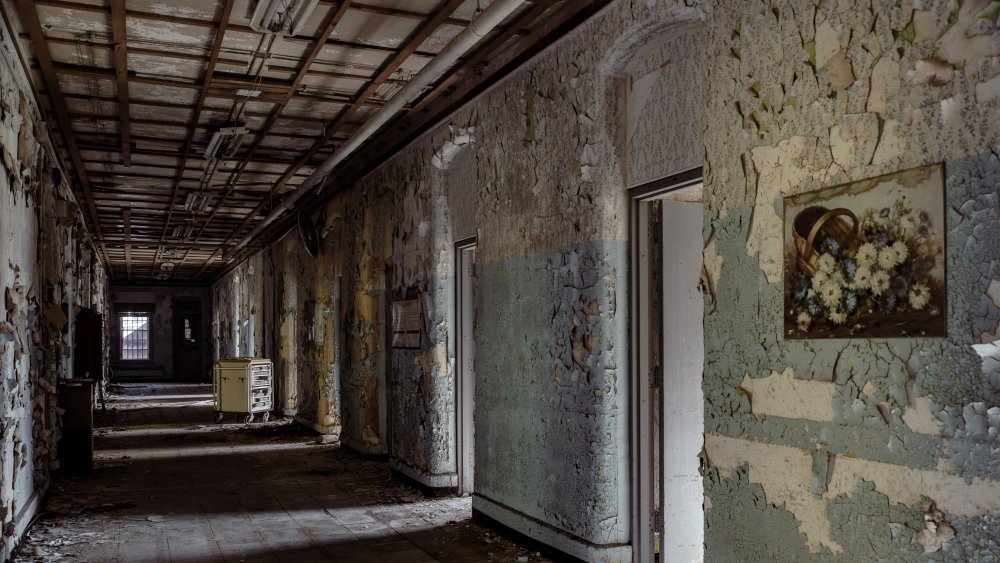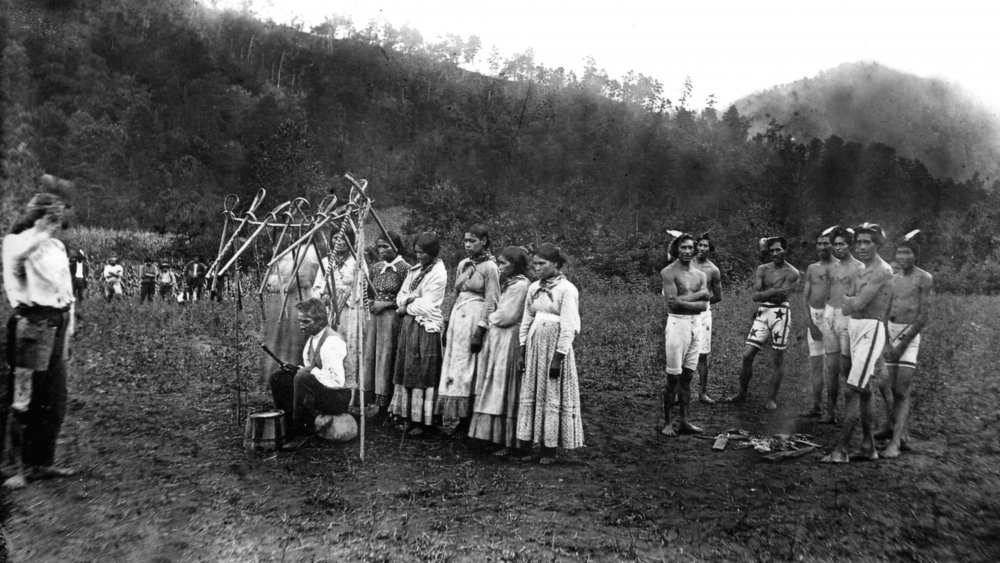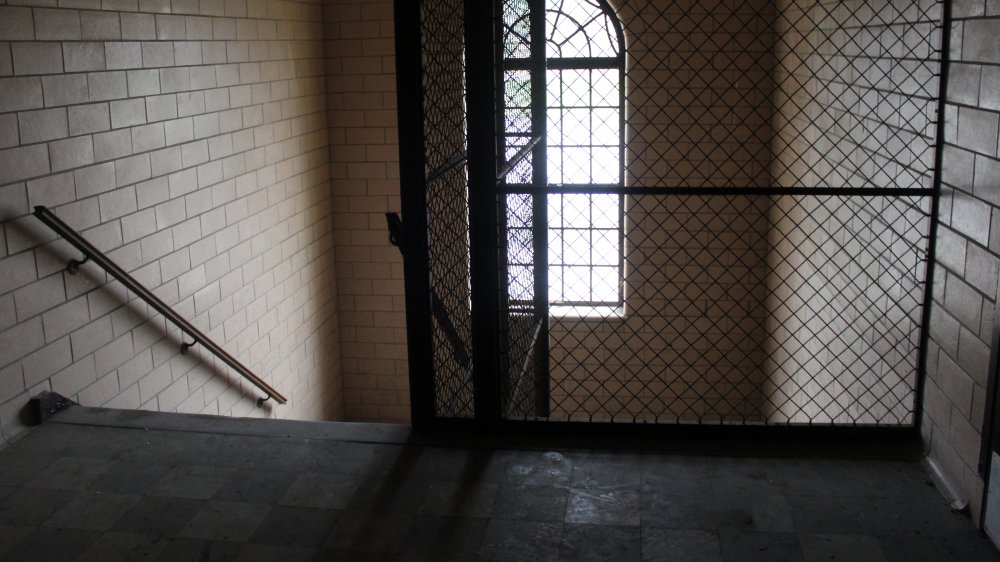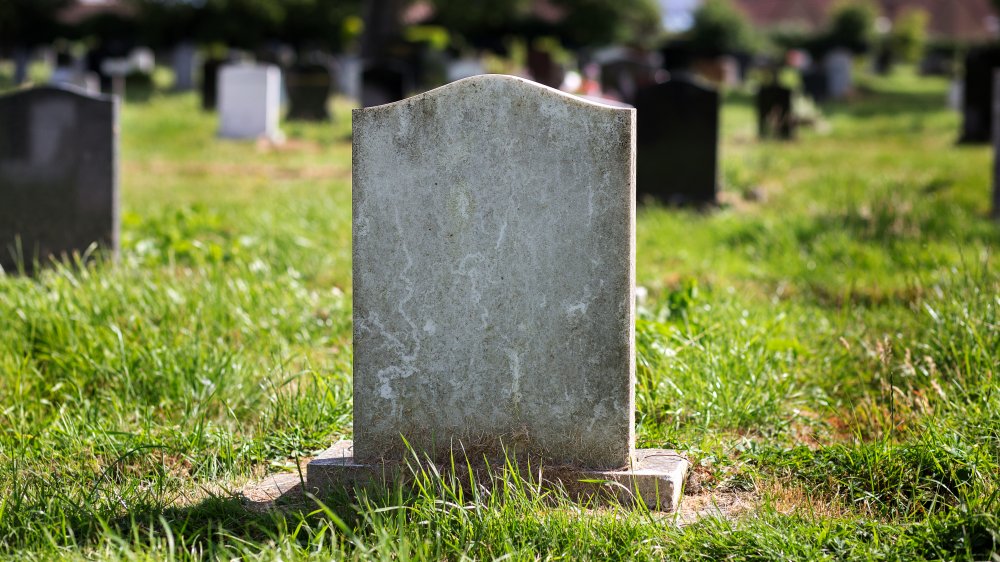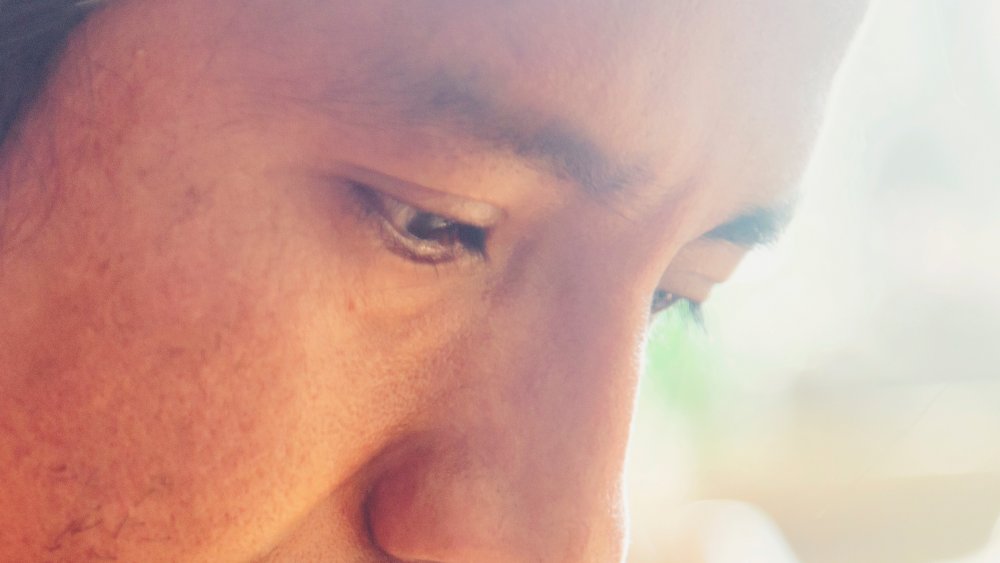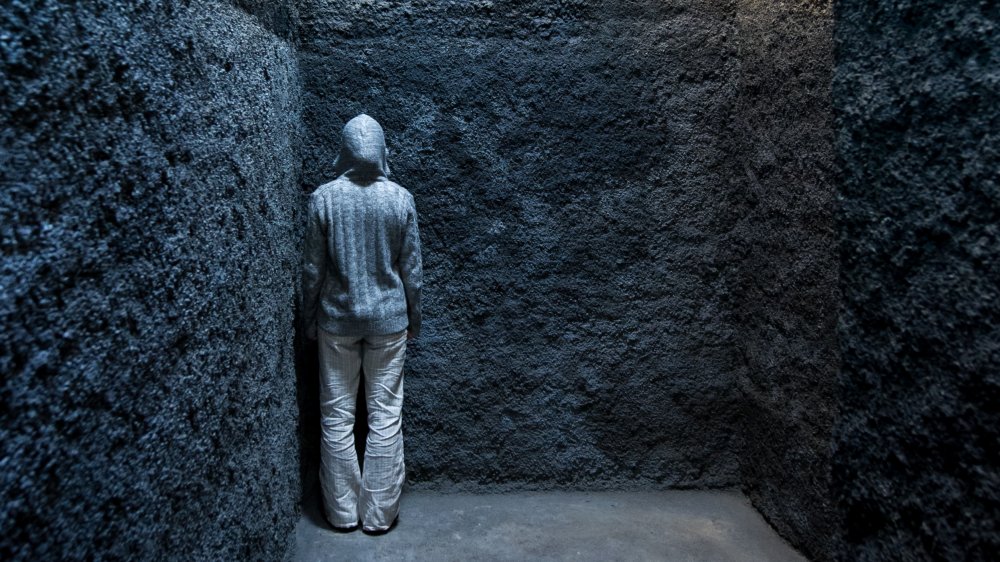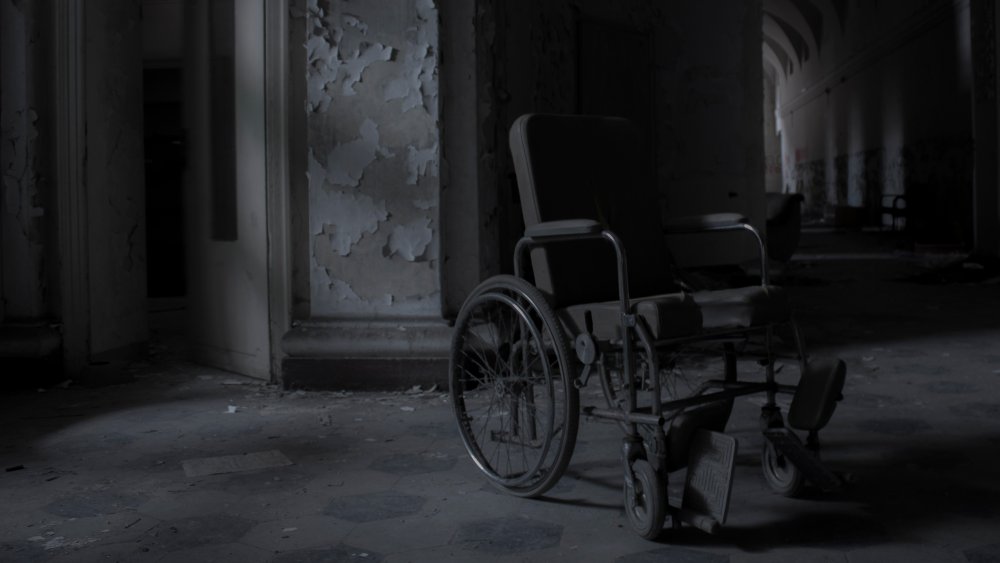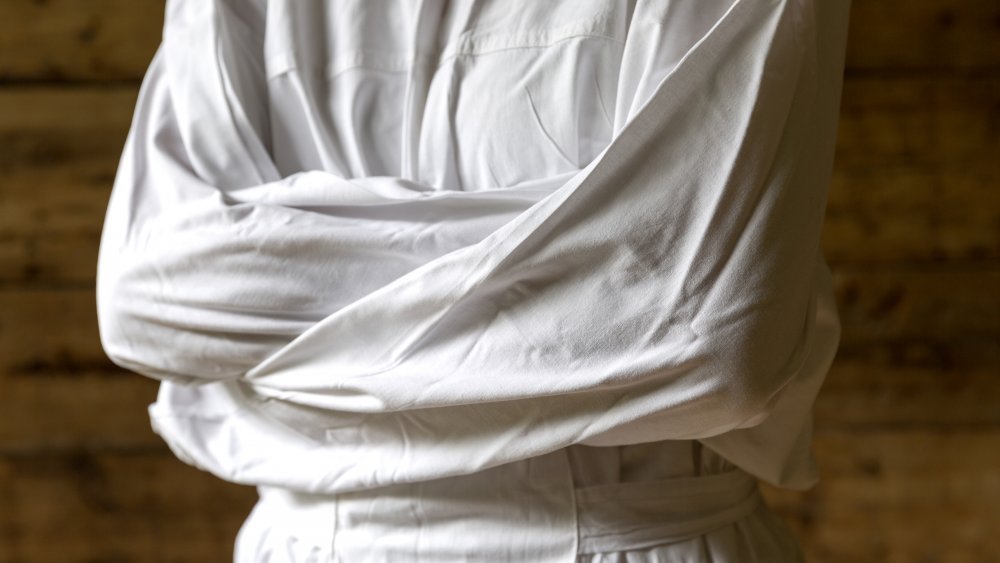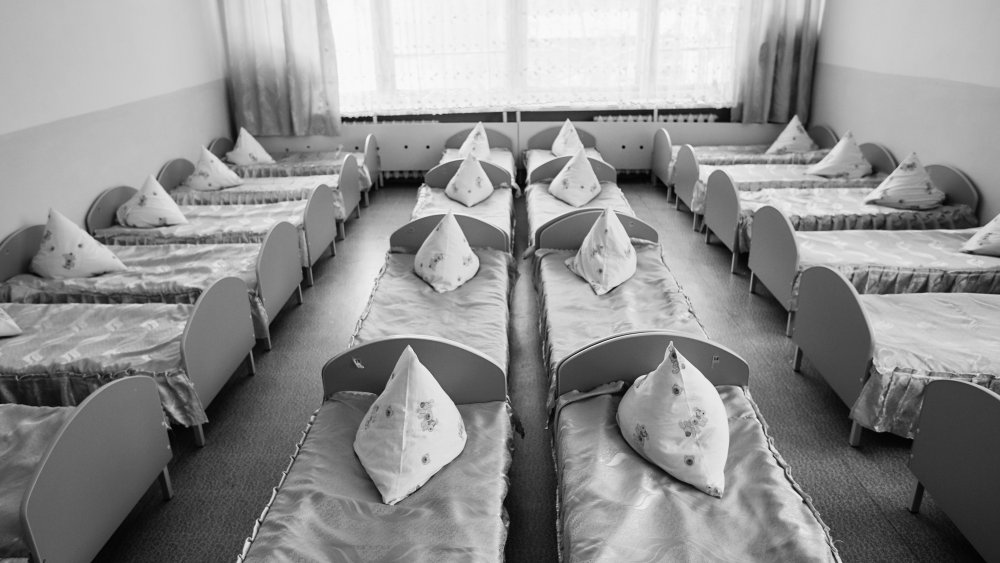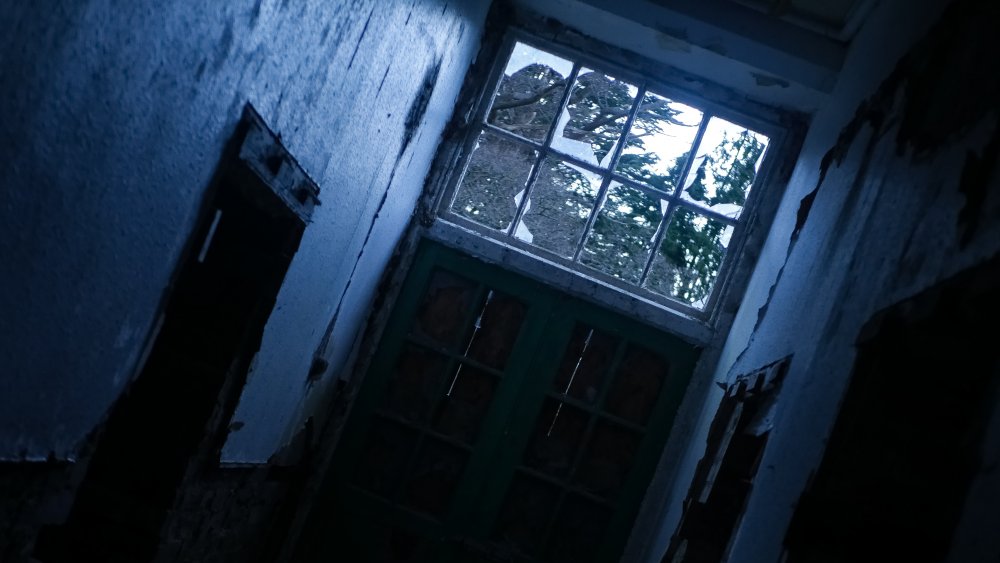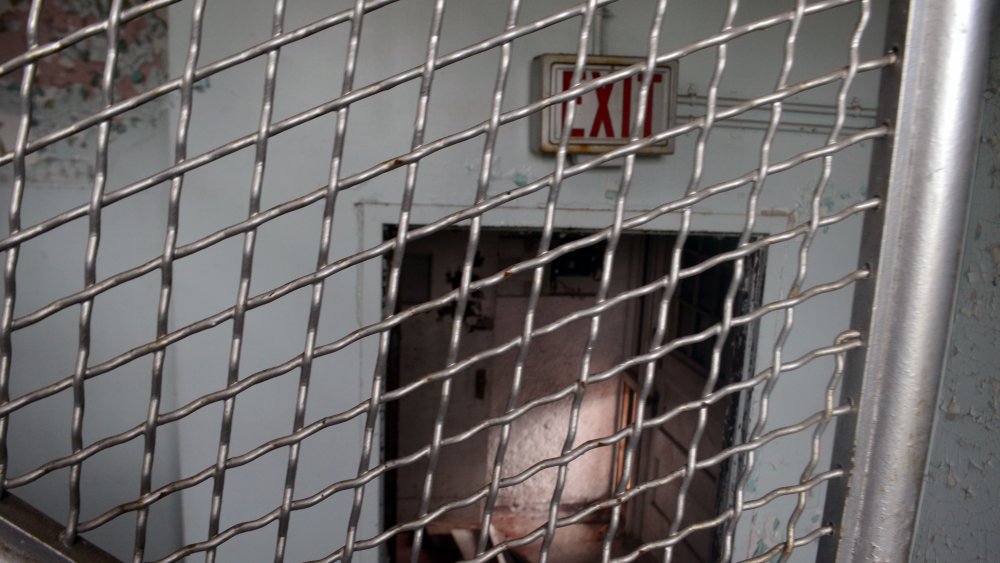The Tragic True Story Of The Hiawatha Insane Asylum
The history of the treatment of mental illness is horrifying and inhumane, but for non-white people in the United States, there is a more insidious side. Those who rejected and revolted against the racist and colonialist status quo were frequently deemed mentally unwell and diagnosed with conditions such as "drapetomania," which affected enslaved people who refused to live in captivity and manifested through escape attempts. To this day, those who speak out about racism risk being institutionalized.
Throughout the 20th century, the United States also incarcerated Native people under the guise of mental treatment. Founded in 1902, the Hiawatha Insane Asylum was the first federally funded mental asylum built for that purpose. Many Native Americans ended up there by opposing business interests or arguing with a reservation agent, and it's impossible to know exactly how many people died there.
The Hiawatha Asylum has been accurately called a gulag, for some records show that Native people imprisoned at Hiawatha manufactured over $1,000 worth of linens and clothing for the asylum. The farce came to an end in 1934, but immeasurable damage had already been done. This is the tragic true story of the Hiawatha Insane Asylum.
The creation of Hiawatha Insane Asylum
The Hiawatha Insane Asylum, also known as the Canton Asylum for Insane Indians, was opened in 1902 in Canton, South Dakota. It was the second federally funded mental asylum in the United States. According to Discrimination Against the Mentally Ill by Monica A. Joseph, the first mental illness asylum in the United States was the Government Hospital for the Insane, later renamed Saint Elizabeth's Hospital, which had been established in 1855. But while theHiawatha Asylum claimed to alleviate the struggles of mentally ill Native people, in actuality, it was a place of great suffering.
According to Indianz, some Native people were sent there for physical illnesses such as tuberculosis or epilepsy, while others were sent for refusing to have their children taken to a mission boarding school or for simply arguing with the Indian agent at their reservation.
The Hiawatha Insane asylum also wasn't the first asylum for Native people in the United States. In 1877, the Cherokee Asylum was opened near Tahlequah, Oklahoma. According to Indian Country Today, thousands of dollars were taken from land sales in order to create the asylum, but admission wasn't limited to those who were mentally ill: "To be destitute was the only universal criteria for admission." In 1904, some of the Cherokee inmates from the Cherokee Asylum were sent to Hiawatha, while others were placed under the management of Oklahoma state.
Justifying the construction and maintenance of Hiawatha Asylum
The Hiawatha Asylum was created by Richard F. Pettigrew, who was one of the first senators from South Dakota. According to "The Canton Asylum for Insane Indians" by Diane T. Putney, the idea of an asylum had been suggested to Senator Pettigrew in 1897 by a United States Indian agent. The agent claimed that it was difficult for Native people to find care in state institutions and "estimated that two insane Indians could be found on every reservation in the United States." But Senator Pettigrew wasn't concerned with humanitarian interests and instead thought that the construction of such a facility might help his fairly new state in its development.
In 1899, Senator Pettigrew introduced a bill in order to purchase land to build an asylum near Canton. Senator Pettigrew asked the Bureau of Indian Affairs how many Native people would benefit from such an institution, and, after polling its superintendents and agents, the BIA claimed that there were "approximately fifty-eight insane and six 'idiotic' Indians living on twenty-one reservations." In 1899, Congress passed Senator Pettigrew's bill and allocated $45,000 for the asylum.
According to the Hearings Before a Subcommittee of the Committee of Indian Affairs of the House of Representatives, by 1912, the asylum was claiming that "the institution is full to overflowing with Indians, for whom there is no hope of cure" and had requested an additional $75,000, which is equivalent in purchasing power to over $2 million today.
The first patients at Hiawatha Insane Asylum
The very first patient at Hiawatha Asylum was Andrew Hedges, a 33-year-old Sioux man who was admitted on December 31, 1902. According to "The Canton Asylum for Insane Indians" by Michelle C. Saxman, Hedges was brought to Hiawatha Asylum directly from the Santee Sioux Reservation in Nebraska. By the end of 1903, the asylum held 16 people from different Native tribes, including the Cherokee, Osage, Winnebago, Comanche, and Pawnee. They were all diagnosed with various mental conditions, such as acute melancholia, chronic mania, congenital epileptic idiocy, and alcoholic dementia.
According to "The Canton Asylum for Insane Indians" by Diane T. Putney, the first death occurred on May 20, 1903, less than six months after the asylum's opening. Robert Brings Plenty was a 21-year-old Sioux from the Pine Ridge reservation in South Dakota and had been diagnosed as "dementia, epileptic chronic." He was reportedly partly paralyzed and suffered an epileptic convulsion during the night that allegedly caused his death.
The first superintendent of the asylum, Oscar Gifford, informed the agent at Pine Ridge reservation, but after apparently getting no request to send the body back for burial, Gifford set aside some land by the asylum where Brings Plenty's body was buried. According to Indian Country Today, over the next 30 years, at least 120 people who died at Hiawatha Asylum would be buried there. The asylum averaged four deaths per month.
Few patients at Hiawatha Asylum were actually mentally ill
There were no formal procedures for commitment, so it's impossible to know how many Native people were imprisoned, and died as a result, at Hiawatha Asylum. During the asylum's 30-some years of operation, at least 350 Native people were admitted, but according to Discrimination Against the Mentally Ill by Monica A. Joseph, few, if any, of them of them actually suffered from mental illnesses.
Many ended up incarcerated for opposing business interests or for merely arguing with a reservation agent. One example is the commitment of Cleto Tafoya, who, according to the Argus Leader, had objected to the fake souvenirs that were sold by trading posts. After the Sante Fe Indian School requested his commitment, he was sent to Hiawatha Asylum on November 13, 1930, and diagnosed as "paranoid."
Some were also imprisoned at Hiawatha asylum for petty crimes or because they had a drinking problem. Others were incarcerated because they suffered from tuberculosis, epilepsy, or developmental disabilities. Those imprisoned at Hiawatha Asylum were also heavily dosed with medications whose side effects included hallucinations, emotional instability, and confusion.
According to Indianz, many imprisoned Native people didn't speak English and, after having been kidnapped from their families and tribal territories, often exhibited feelings of disengagement and agitation. Those who worked at the asylum, like Dr. John F. Turner, who didn't have a background in psychiatric care, considered these behaviors to be symptomatic of mental illness rather than a by-product of cruel and unusual treatment.
Hiawatha Insane Asylum was a place of neglect
The treatment at Hiawatha Asylum was essentially a farce, with inadequate staff and abhorrent neglect of Native people. According to "Honoring the Dead" by Kennedi Ford, between 1903 and 1923, the asylum discharged 204 Native people, and 137 of those discharges were due to the death of the patient. Out of those 204, only 35 were considered to have "recovered." Eleven patients escaped over those 20 years, but four were reportedly retrieved.
According to "The Canton Asylum for Insane Indians" by Diane T. Putney, Harry Hummer, who replaced Oscar Gifford as superintendent in 1908, refused to let families visit patients, since he believed that this activity would slow a patient's recovery. However, he was fine with patients being shown off to paying visitors, so it's unlikely that Hummer was truly thinking of the patients' supposed recovery. Whatever staff the asylum had were poorly trained, if they were trained at all, and many dealt with Native people by choking, shaking, striking, and/or kicking them. The patients were also kept medicated and often were isolated for years at a time.
While the building had plumbing and electricity, it wasn't available in the rooms of imprisoned Native people. Instead, they were given chamber pots with no covers that were rarely emptied by staff. The windows of the building were also sealed shut in order to prevent escapes, and as a result, the rooms that Native people were confined to had hardly any fresh air to breathe.
Six "doctors" for the entire asylum
In July 1925, after Commissioner Burke made an inspection of the asylum, he was dismayed to see multiple unattended patients. According to "An Invitation to Restorative Justice" by Anne Dilenschneider, there was only one attendant to supervise over 90 imprisoned Native people. Commissioner Burke advocated for increasing the asylum's budget, but Hummer rejected his suggestion to hire more attendants, even though he admitted that only six attendants worked at Hiawatha Asylum. At most, there were perhaps 13 people who worked there at one time.
The first time a trained nurse was hired at the institution was April 1927, almost 25 years after its opening. There were no trained medical staff when Hiawatha opened, and for the first eight years, there wasn't a single psychiatrist.
According to "Honoring the Dead" by Kennedi Ford, the situation was unchanged in 1929, when Dr. Samuel Silk went to Hiawatha Asylum for an inspection and found that there were still only six attendants working and only two during the night shift. During the night shift, the two attendants were responsible for at least 24 Native people per floor. According to Indian Country Today, in addition to physical abuse, the attendants also sexually abused the Native people imprisoned at Hiawatha and would later brag about the violations they'd perpetrated.
Native people at Hiawatha Asylum were kept in chains
Three kinds of restraints were typically used at Hiawatha Asylum. Ankle chains and straitjackets were used primarily for imprisoned Native people in isolation, while metal wristlets were employed when there was no space to seclude people. During his inspection in 1925, Commissioner Burke noticed Native people who were restrained with steel anklets connected to a chain, shackled to either a radiator or a bed. Many were simply kept isolated in a straitjacket.
According to "An Invitation to Restorative Justice" by Anne Dilenschneider, a ten-year-old boy at Hiawatha Asylum was kept in a straitjacket because he kept ripping off the clothes that the attendants had forced him into since he arrived at the asylum. During his inspection in 1929, Dr. Silk detailed the use of restraints on the boy, which even he considered unnecessary, since although "this patient is rather a problem because of his untidiness and dribbling of saliva, [he] is otherwise harmless."
Native people were chained to their beds for months or even years at a time. Sometimes, the keys to undo their restraints had been lost. Others were simply tied to their beds.
Abysmal record-keeping at Hiawatha Asylum
Several investigators who went to Hiawatha over the years found that the record-keeping was abysmal. There were little to no records regarding Native peoples' admission to the institution, their prescribed treatment, or their progress. According to "An Invitation to Restorative Justice" by Anne Dilenschneider, the records that did exist had diagnoses of which the imprisoned Native people had no symptoms.
Despite the fact that Hiawatha Asylum required that every Native person admitted into the asylum to be authorized by the commissioner of Indian affairs, in 1933, the Bureau of Indian Affairs admitted that there were absolutely no documents regarding the Native people who had been confined at the asylum.
Hummer's own record-keeping was consistently poor between 1909 to 1929. According to "The Canton Asylum for Insane Indians" by Diane T. Putney, Hummer didn't even have any reliable records of any physical examinations done on patients, not even those who may have been suffering from tuberculosis. Dr. Silk noted the particular lack of medical care for tubercular patients in his report as cause for concern because at least 50 percent of the deaths at Hiawatha Asylum were due to tuberculosis.
Baby Faribault
By 1922, Hummer had begun imprisoning Native children as well, such as 12-year-old Henry Frenier and ten-year-old Amelia Moss. And according to "An Invitation to Restorative Justice” by Anne Dilenschneider, at least seven children were born at the institution. However, it's ultimately unclear how many people got pregnant during their time at Hiawatha Asylum or how many of those pregnancies resulted from rape.
One of the children born at Hiawatha asylum was Winona Faribault. Her mother, Elizabeth Faribault, had been imprisoned at Hiawatha asylum in 1915 when she was 22 years old, after the Sisseton Agency, which serves the trust land of the Sisseton-Wahpeton Oyate, claimed that she was "homicidal." Elizabeth tried to escape twice, once in January 1920 and again in September 1921. She wrote letters pleading her case to the Indian Commissioner in Washington, D.C., while friends and family sent a petition demanding her release. However, she remained imprisoned until her death on March 2, 1928.
Elizabeth Faribault reportedly began a relationship with Willie Dayae, a Diné, and their daughter Winona was born on September 28, 1926. Hummer reportedly kept "Baby Faribault" at the asylum until she was almost four years old, and when Winona was nine months old, he had already diagnosed her as an "imbecile." But by 1930, it was obvious that Winona was not showing signs of mental illness, and in order to avoid an inquiry, Hummer sent her to an orphanage in Arizona.
Power struggles at Hiawatha Insane Asylum
Despite the fact that there were so few employees, those who worked at Hiawatha Asylum were involved in power struggles, often initiated by Hummer. All the tension created an environment of resentment, unease, and mistrust. According to "The Canton Asylum for Insane Indians" by Diane T. Putney, in 1927, Hummer begrudgingly hired a nurse, but she barely lasted a year. After she left, Grace C. Fillius came on as head nurse, but she and Hummer immediately began butting heads. Fillius pointed out to Hummer changes that needed to be made at the asylum, and Hummer retaliated by threatening and bribing employees to testify against Fillius' qualifications.
According to "Honoring the Dead" by Kennedi Ford, Hummer asked every worker, including the kitchen help, to sign affidavits against Fillius. After Fillius finally resigned in 1929, Hummer fired Doretta Koepp, another nurse who'd aligned herself with Fillius, in addition to Robert Stengle, Lewis Larson, and several other employees who had refused to help Hummer in his crusade against the two nurses.
Back in 1909, 13 workers from Hiawatha demanded that the Bureau of Indian Affairs begin an investigation into Hummer's mistreatment of the Native people imprisoned at Hiawatha. However, during the investigation, Dr. Joseph Murphy found that Hummer was "financially and morally 'above reproach.'" And in 1914 and 1915, Hummer was also accused of misconduct with women who had worked at the asylum. This investigation was conducted quietly and cleared Hummer of any charges.
Dr. Silk's report helped to close Hiawatha Insane Asylum
Ultimately, it was Dr. Silk's visit and report in 1929 that led to the closing of Hiawatha Asylum. According to "Honoring the Dead" by Kennedi Ford, in his report, Dr. Silk condemned the excessive use of straitjackets and isolation, commented on the frightfully small number of employees, and was overall highly critical and dismayed at the lack of care provided at the institution.
According to "An Invitation to Restorative Justice" by Anne Dilenschneider, Dr. Silk discovered that there was no light in Hiawatha because Hummer declined to spend any money on electricity, despite the fact that the asylum had 120 electric light fixtures. And while there were also tiled bathrooms with flushable toilets, they were used as storage rooms.
Dr. Silk wrote in his report that Hiawatha Asylum was a place of all around "intolerable conditions," with the "poorest kind of medical care," whose cleanliness was "very much below the standard of a modern prison." Even he was able to admit that "at the time of inspection of the Institution [patients] did not show any active evidence of mental disease."
M.C. Guthrie, the chief medical director of the Office of Indian Affairs, responded to this report with a recommendation that the asylum be expanded to hold at least 150 more people.
The nightmare at Hiawatha asylum is somewhat brought to an end
Despite Dr. Silk's 1929 report, Hiawatha Asylum stayed open with few changes to its operations until 1933. John Collier was made federal commissioner of Indian Affairs earlier that year, but he didn't take note of Hiawatha until Severa Tafoya wrote to him on behalf of her husband, Cleto, who had been imprisoned at Hiawatha for three years. According to "The Canton Asylum for Insane Indians" by Diane T. Putney, Tafoya may not have been the only person reaching out to Collier on behalf of a loved one.
After reading Dr. Silk's 1929 report along with a more recent report done in 1932, Collier decided that Hiawatha Asylum should close down and that the people imprisoned there should be transferred to Saint Elizabeth's. The city of Canton pushed back against the closure of Hiawatha, claiming that it would result in a loss of jobs for the area. G.J. Moen, part of the Canton Chamber of Commerce, even filed an injunction to prevent the closure, but it was overturned in federal court.
Sixty-nine Native people were transferred from Hiawatha Asylum to Saint Elizabeth's in Washington, D.C., on December 21, 1933. Two more were transferred at a later date. Sixteen Native people were reportedly freed and allowed to return to their reservations, but, tragically, they were most likely sterilized against their well before they were released. By April 1934, Hiawatha Asylum had officially closed, although South Dakota continued to use it as a penitentiary until 1946.
